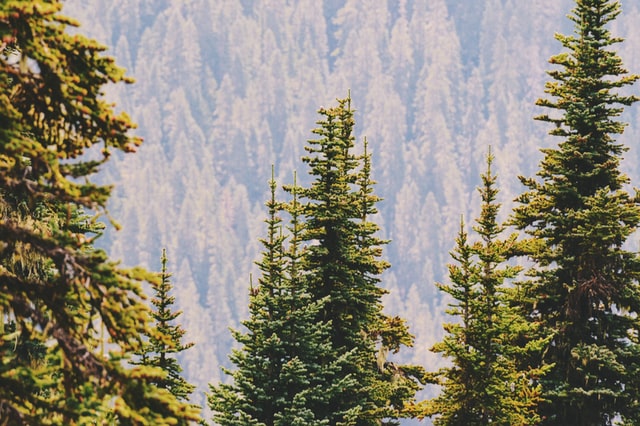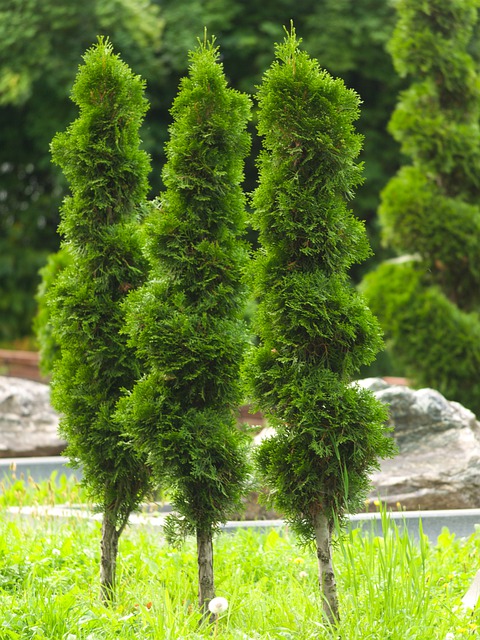This excerpt has been extracted from “The well – designed mixed garden”. The Conifers are cone-bearing seed plants with vascular tissue; all extant conifers are woody plants, the great majority being trees with just a few being shrubs. “Tree Service in Oakland“, provides essential information on growing of the Conifers.
Conifers
Dwarf of slow- growing conifers are normally the best conifers for the mixed garden, except in the case of plants for hedges. I have found the American Conifer Society to be a great source of information and follow many of their guidelines. It is best to plant or transplant conifers in the spring in the spring or early autumn, when temperatures are cooler and there is some rain. Conifers in amended soil don’t normally require additional fertilizing; topdressing is usually sufficient. Some conifers, however, such as hemlocks, prefer a slightly acidic soil and would benefit from the cottonseed- alfalfa-sulfur fertilizer described earlier. If conifers look like they are failing, they can be given a boost with iron sometime during January, February, or March. Mulching is essential for conifers; it helps to maintain a cool, moist root zone, but no more than 2-3 in. is necessary, and it shouldn’t come in contact with the trunk of the plant.

Pruning of most conifers will be minimal if the proper plants were selected in the first place. But even slower-growing conifers may outgrow their space in a mixed border before one is ready to part with them. One recommendation: when the conifer gets to within one foot or so of the desirable size, it is best to cut back the new growth so that about 1 in. of its left. This will cause side branches to form and create a dense plant. Once this growth has established, continue to maintain the size of the plant by cutting off any undesirable new growth. Conifers may also require some thinning to allow air and light into the plant. Fairly commonly, cultivars of dwarf and variegated conifers revert to the typical form; remove the wayward branch, pruning well into the area where the mutation originated. Pruning for size control of conifers varies from genus to genus, and care must be taken not to damage their natural shape. It is best not to remove more than one-third of the total growth of a conifer with pruning. Most pruning for size or shape control should be done when the conifer is dormant.
Pines can be pruned by technique called candling. The soft new growth that develops on the tip of the branches in the spring is called a candle. It can be pinched or cut off by one-half or two-thirds before the needles fully elongate. Buds will then develop below the cut. Pines do not develop buds along the stem, so shearing or heavy pruning into old wood will not rejuvenate the plant.
Douglas fir (Pseudotsuga menziesii), spruces (Picea spp.), and firs (Abies spp.) have visible buds along the current season’s growth and often along the stems of the previous season’s growth. Prune the tips of stems back to a side or lateral bud, or branch, for size control; this heading back, as it is sometimes called, produce denser foliage and a smaller plant. If a formal effect is desired, these conifers can be pruned or sheared when the current season’s growth is soft.
Arborvitaes (Thuja spp.), false-cypress ( Chamaecyparis spp.), and junipers ( Juniperus spp.) can be pruned or sheared lightly, just after new growth emerges but with care because they lack viable buds on the leafless inner portions of the branches. Cutting back into this woody zone normally will not produce new foliage, nor will heavy pruning of these plants rejuvenate an overgrown plant. It is best to perform periodic pruning, so that a major rejuvenation of the plant is not necessary. Avoid heavy pruning of specimen plants, as their natural habit will be lost.

Hemlocks (Tsuga spp.) and yewa (Taxus spp.) have buds on old and new wood, making them the easiest conifers to prune or shear for use as hedges. Pruning in the spring before new growth develops produces a soft, more natural-looking effect. These to shear them annually to keep hedges in shape. Remember to prune hedges so that the upper portion is narrower than the base, allowing light to reach lower foliage. Horticultural oils, applied during the dormant season, may be needed as a preventive measure against outbreaks of mites, scale, or aphids on susceptible evergreens.
Continue reading on Pollarding

